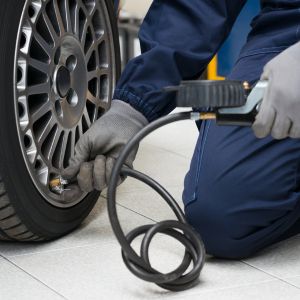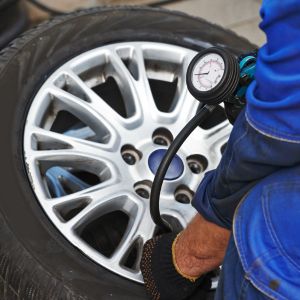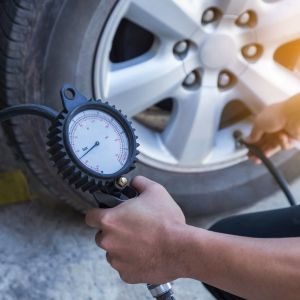Optimum air pressure in tyres is important for safety, fuel efficiency, tire longevity, comfort, cost-effectiveness, and environmental sustainability. Properly inflated tires provide good handling and traction, maximise fuel efficiency and tire longevity, provide a comfortable ride, and save money in the long run by reducing the need for frequent tire replacement.
It is important to inflate the tires to the recommended pressure, and check the air pressure at least once a month, and before long trips, using a reliable tire gauge. Car tyre punctures can significantly affect the performance and safety of the vehicle. Therefore, maintaining the optimum air pressure in tyres is crucial to minimize the risk of car tire punctures and ensure a smooth and uninterrupted driving experience.
What is optimum pressure in tyres?

Optimum pressure in tyres is the level at which the tire is filled with enough air to support the weight of the vehicle, provide good handling and traction, and maximise fuel efficiency and tire longevity. It’s the level of air pressure that is recommended by the vehicle manufacturer and/or tire manufacturer.
The recommended air pressure is based on the specific make, model, and year of the vehicle, as well as the type of tire. It’s important to inflate tires to the optimum air pressure as it can help to prevent issues such as poor fuel economy, uneven tire wear, and decreased handling and stability. It is also important to check the air pressure in the tires at least once a month and before long trips, using a reliable tire gauge.
Importance of Optimum pressure in tyres

Maintaining optimum air pressure in tyres is important for a number of reasons. Here are a few key points:
- Safety: Properly inflated tires help to ensure that your vehicle handles well and provides good traction on the road. Under-inflated tires can lead to decreased handling and stability, which can increase the risk of accidents. Over-inflated tires can also lead to poor handling and an increased risk of blowouts.
- Fuel efficiency: Tires that are properly inflated can help to maximize fuel efficiency. When tires are under-inflated, they create more rolling resistance, which can lead to decreased fuel economy.
- Tire longevity: Tires that are properly inflated can last longer than those that are under-inflated or over-inflated. Under-inflated tires can lead to uneven wear and can cause the tire to wear out more quickly. Over-inflated tires can lead to excessive wear on the centre of the tread.
- Comfort: Tires that are properly inflated can help to provide a more comfortable ride. Under-inflated tires can lead to a bumpy ride and can cause the vehicle to bounce around on the road. Over-inflated tires can lead to a harsh ride.
- Cost-effective: Properly inflated tires can save you money in the long run. Under-inflated tires can lead to decreased fuel economy and can cause the tires to wear out more quickly. This can result in having to replace tires more often, which can be costly.
- Environmentally friendly: Properly inflated tires can help to reduce the environmental impact of your vehicle. Tires that are under-inflated can lead to increased fuel consumption, which can result in more emissions from the vehicle.
It’s essential to inflate tires to the recommended pressure, not the maximum pressure printed on the sidewall, as that can help to ensure that your tires are at the optimum air pressure. It’s also important to check the pressure in tyres in your tires at least once a month, and before long trips, using a reliable tire gauge.
Optimum Air Pressure in Tyres

The optimum pressure in tyres is the level at which the tire is filled with enough air to support the weight of the vehicle and provide good handling and traction. Here are some key points to consider:
- The recommended air pressure for your tires can be found in the vehicle owner’s manual or on a sticker located on the driver’s side door jamb or glove box.
- The correct air pressure is also listed on the sidewall of the tire itself, usually in both PSI (pounds per square inch) and kPa (kilopascals).
- The recommended air pressure is specific to the make, model, and year of your vehicle, as well as the type of tire (e.g. summer, winter, all-season).
- Under-inflation or over-inflation can cause a number of problems, such as poor fuel economy, uneven tire wear, and decreased handling and stability.
- It’s important to check the air pressure in your tires at least once a month, and before long trips, using a reliable tire gauge.
- The pressure should be checked when the tires are cold, as the pressure increases when the tires heat up from driving.
- Always inflate your tires to the recommended pressure, not the maximum pressure printed on the sidewall.
- It’s also important to make sure that the tires are properly balanced and aligned, as these can affect the wear and performance of your tires as well.
Frequently Asked Questions
Q1. What is the correct air pressure in tyres?
Ans: The correct air pressure in tyres can vary depending on the make and model of your vehicle, as well as the type of tire. You should consult the vehicle owner’s manual or the tire sidewall to determine the recommended pressure for your specific tires.
Q2. Is 40 psi pressure in tyres too high for tyres?
Ans: 40 PSI can be considered high for some tires, but it depends on the recommended pressure for your specific tires.
Q3. Is pressure in tyres 35 too high?
Ans: 35 PSI can be considered high for some tires, but it depends on the recommended pressure for your specific tires.
Q4. Is 36 too high pressure in tyres?
Ans: 36 PSI can be considered high for some tires, but it depends on the recommended pressure for your specific Tires.
Q5. Is 40 PSI good tyre pressure for SUVs?
Ans: Recommended tyre pressure for SUVs varies by the make and model of the vehicle and the type of tire. It’s best to consult the vehicle owner’s manual or the tire sidewall to determine the recommended pressure for your specific SUV.

